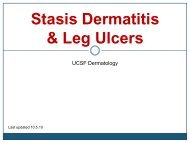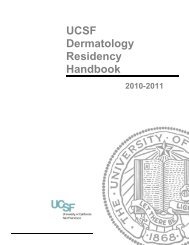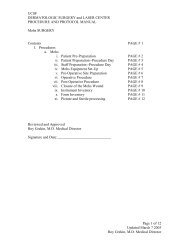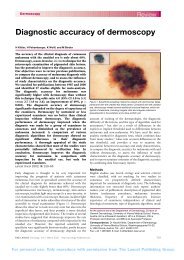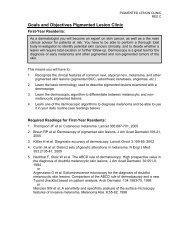An overview of sexually transmitted diseases. Part III ... - Dermatology
An overview of sexually transmitted diseases. Part III ... - Dermatology
An overview of sexually transmitted diseases. Part III ... - Dermatology
You also want an ePaper? Increase the reach of your titles
YUMPU automatically turns print PDFs into web optimized ePapers that Google loves.
J AM ACAD DERMATOL<br />
VOLUME 43, NUMBER 3<br />
tiple HPV types, including oncogenic types. 146,158-60<br />
Clinically, although HIV patients may have the same<br />
condylomas as normal persons, they may also have<br />
more extensive or even disseminated condylomas<br />
that may be relatively refractory to treatment.<br />
Furthermore, HIV-infected patients’ condylomas are<br />
associated with a significant risk <strong>of</strong> transformation<br />
into squamous cell carcinoma.<br />
Proper diagnosis is essential in these cases.<br />
Usually, anogenital warts are diagnosed by clinical<br />
acumen, but in HIV-infected patients biopsy should<br />
be considered before therapy so that appropriate<br />
diagnosis <strong>of</strong> dysplastic changes or squamous cell<br />
cancer can be ascertained early in the disease management<br />
process. 1,158 Treatment options available to<br />
the HIV-infected host do not differ from those available<br />
to the immunocompetent host and are discussed<br />
by Brown, Tyring, and Yen-Moore 161 in part II<br />
<strong>of</strong> this series on <strong>sexually</strong> <strong>transmitted</strong> <strong>diseases</strong>. Some<br />
clinicians advocate treatment by excision and electrodesiccation<br />
because <strong>of</strong> the poor response and frequent<br />
recurrences after topical treatments 162 and<br />
the association between HPV and cancer in this population.<br />
158,163<br />
Notwithstanding, some studies have evaluated<br />
nonsurgical treatment modalities for genital warts<br />
in the immunocompromised host. Podophyllotoxin<br />
has been studied for genital warts in HIV-positive<br />
Tanzanian patients, 164 but given the association <strong>of</strong><br />
HPV in HIV-infected patients with squamous cell<br />
cancer, this therapy may be inappropriate for this<br />
population. 165 Interferon has been studied in this<br />
population, 166,167 as has imiquimod. 168 Although<br />
both have some efficacy in treating HPV infection in<br />
HIV patients, neither appears to be effective as<br />
monotherapy in completely clearing clinical lesions<br />
from the most severely immunocompromised<br />
patients. Use <strong>of</strong> imiquimod as adjunctive therapy<br />
after surgical or cytodestructive treatment <strong>of</strong><br />
condyloma acuminatum does appear effective in<br />
HIV-seropositive and in other immunocompromised<br />
patients in terms <strong>of</strong> significant delays or prevention<br />
<strong>of</strong> recurrences. Cid<strong>of</strong>ovir gel has been<br />
studied in a phase I/II trial <strong>of</strong> HIV-positive patients<br />
with condylomata acuminata and appears safe and<br />
potentially effective in this population. 169 Finally,<br />
Orlando et al 170 recently reported that relapse<br />
rates <strong>of</strong> condyloma in HIV-infected patients<br />
decreased with improved treatment <strong>of</strong> their underlying<br />
HIV infection with antiretroviral medication.<br />
Successful treatment <strong>of</strong> condylomas thus appears<br />
easier when a person’s underlying HIV infection is<br />
better controlled. Clearly, treatment <strong>of</strong> HPV infections<br />
in HIV-infected patients is an issue that<br />
deserves further study.<br />
Czelusta, Yen-Moore, and Tyring 419<br />
MOLLUSCUM CONTAGIOSUM<br />
The association between HIV infection and molluscum<br />
contagiosum was first noticed in 1983<br />
through an autopsy study <strong>of</strong> 10 patients with<br />
AIDS. 171 Many reports <strong>of</strong> severe and atypical infections<br />
have surfaced, and in AIDS patients, the prevalence<br />
<strong>of</strong> molluscum contagiosum lesions ranges<br />
from 5% to 18%. 172-176 Dann and Tabibian 177 document<br />
molluscum contagiosum as one <strong>of</strong> the 3 most<br />
common reasons nondermatologists referred HIVinfected<br />
patients to a university-based immunosuppression<br />
skin clinic.<br />
In HIV-infected patients, molluscum contagiosum<br />
manifests itself most commonly when immune function<br />
has been dramatically reduced. Several studies<br />
document that molluscum contagiosum infection is<br />
a clinical sign <strong>of</strong> marked HIV progression and very<br />
low CD4 cell counts. 176,178-181 Specifically, when the<br />
CD4 cell count drops below 200/mm 3 , the incidence<br />
<strong>of</strong> molluscum contagiosum appears to increase dramatically.<br />
182 The unfortunate clinical correlate with<br />
this finding is that AIDS patients in whom molluscum<br />
contagiosum occurs have a poor prognosis,<br />
with a median survival time <strong>of</strong> 12 months in one<br />
study. 176 The presence <strong>of</strong> mollusca, however, does<br />
not appear to be an independent prognostic indicator<br />
after accounting for immunosuppression.<br />
Considerable debate remains as to whether the<br />
disease is caused by the reactivation <strong>of</strong> latent virus or<br />
whether it represents a recently acquired infection<br />
complicating patients’ progressive immunosuppression.<br />
The molluscum contagiosum virus commonly<br />
infects the general population. In an Australian study<br />
incorporating both HIV-positive and HIV-negative<br />
patients, 23% <strong>of</strong> the studied population had antibodies<br />
consistent with either a current or previous<br />
infection. 183 As the age <strong>of</strong> the studied population<br />
increased, so did the frequency <strong>of</strong> molluscum contagiosum<br />
antibodies. 183 These findings were believed<br />
to support the theory that mollusca in AIDS patients<br />
reflect the reactivation <strong>of</strong> a latent infection. 184<br />
However, other studies contradict this supposition.<br />
Molecular research demonstrates that molluscum<br />
contagiosum viruses can be divided into two<br />
major types (designated MCV-1 and MCV-2) based<br />
upon restriction fragment cleavage patterns <strong>of</strong> the<br />
viruses’ genome. 185 Although it is not yet clear what<br />
clinical implications these types may have, the ratio<br />
<strong>of</strong> MCV-1 to MCV-2 in one Japanese population was<br />
found to be 13:1. 186 MCV-1 occurred in highest frequency<br />
in children and adult women, whereas MCV-<br />
2 occurred more frequently in adult men and<br />
patients with HIV. 186 This study was consistent with<br />
an earlier Australian study that showed HIV-positive<br />
patients were significantly more likely to be infected




